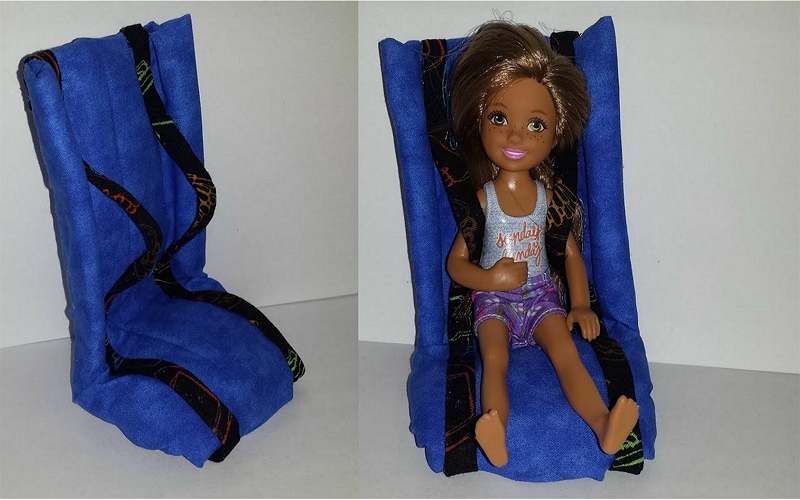How to make a barbie baby car seat? A barbie baby car seat is a great idea for kids that love to play with their dolls.
They feel like they are taking care of the infant and providing it with safe transportation in case you need to go somewhere.

Steps on Making A Barbie Baby Car Seat
Step 1 – Making one is fairly easy, but this article will tell you how to make sure you get all the materials right so everything turns out perfect when finished!
Step 2 – It’s important not only what type of material is used, but also where it comes from. – Get your supplies ready before starting on anything else because once glue gets involved there’s no turning back until its dries!
A fun craft that kids can do on their own or with a friend. Various amounts of fabric will be needed for this project depending on how big you want the doll seat to be and if it has armrests, etc., so make sure to have enough before starting!
Step 3 – Make your barbie baby car seat by cutting out two large pieces from each fabric to create both sides of the finished product.
Step 4 – Use hot glue when attaching everything because it’s strong enough but won’t take forever for things to dry as some other types would.
Step 5 – Allow at least an hour or more depending on how much is being used for everything inside and outside of the actual seating area itself including any added features such as extra cushioning.
How can I test my child’s car seat?
It is important to make sure your child’s car seat fits properly and keeps them safe. You can do this by checking the following:
* Make sure there are no gaps between the back of their neck and where it meets the top of their shoulders, as well as under them – more than two fingers should fit here.
* The harness straps need to be tight enough that you cannot pinch excess webbing at shoulder level with one finger (it would not be painful for a baby).
When fitted correctly, buckled securely in place, they should stay put when lifted from either side. It’s also recommended that children sit rear-facing until at least 12 months old or 20 pounds (whichever comes first).
What’s the pinch test for car seats?
The pinch test is used to check the fit of car seats. The harness straps need to make a V shape with enough room for one finger between the strap and your child’s collarbone or neck (the pinch test). This ensures that your baby can’t slip out of its seat under any circumstances.
Where should the straps be on an infant car seat?
The shoulder straps should be over the child’s shoulders and across their chest. Never allow an infant car seat to hang from its handle or push bar, especially when you are moving it between cars. Use both hands to carry the seat at all times; do not swing it by one strap alone.
When should you adjust car seat straps?
Car seat strap adjustment is an important part of car seat use. When you are adjusting the straps, it should be snug on your child but not too tight that they feel uncomfortable or can’t breathe comfortably while in their car seats.
You will want to make sure there aren’t any gaps present between the child and the harness itself because this could cause serious harm if ever involved in a crash.
Doing some simple test checking for loose straps every once in a while may prevent further injury later down the road when accidents do happen unexpectedly.
It is also important to never leave children unbuckled unless necessary even with airbags installed since the proper installation of restraints has been shown to reduce fatalities by 71% among infants under age one who was in crashes.
How tight should baby car seat straps be?
The harness should be snug and the chest clip should lay flat across your child’s chest, below their armpits. The straps shouldn’t pinch or leave red marks on the baby’s shoulders when you adjust them correctly.
They also shouldn’t fall off of the baby’s shoulder either! Adjusting the straps is fairly simple once you get used to it – there are usually two loops in front that can tighten or loosen with a quick pull of each strap on one side at a time.
You’ll want to make sure they’re tight enough so that your child can not slip out but not too tight where it restricts breathing room for little ones who tend to sit slumped over while sleeping (and possibly snore!).
Once you have everything set, you can test it yourself by trying to wiggle the baby’s arms and legs – if they’re moving, the straps are not too tight!
What is the safest car seat 2020?
A car seat 2020 is the safest when it fits your child’s age, size, and physical development. A rear-facing car seat 2020 provides more protection than a forward-facing one because of its design.
The American Academy of Pediatrics recommends that children stay in this position until they are at least two years old or weigh 20 pounds (lbs). Children should then move into an upright or front-facing seat with harnesses for as long as possible before moving to booster seats 2020.
Booster seats help distribute crash forces evenly across their body. This reduces injury risk by up to 80%. In addition to following these guidelines, parents can also take extra precautions such as choosing vehicles with good structural designs and airbags in 2021, properly installing their child’s car seat and practising safe driving behaviours in 2021 .
